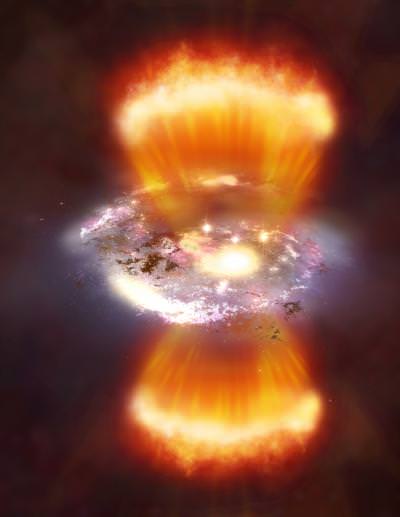[/caption]
Scientists have found evidence of a catastrophic event they believe was responsible for halting the birth of stars in a galaxy in the early Universe. According to their findings, just 3 billion years after the Big Bang, a massive galaxy exploded in a series of blasts trillions of times more powerful than any caused by an atomic bomb. The blasts happened every second for millions of years. "We are looking into the past and seeing a catastrophic event that essentially switched off star formation and halted the growth of a typical massive galaxy in the local Universe," said lead author Dr. Dave Alexander from Durham University.
Using the Gemini Observatory's Near-Infrared Integral Field Spectrometer (NIFS), scientists looked at SMM J1237+6203 and noticed properties seen in other massive galaxies near to our own Milky Way, which suggest that a major event rapidly turned off star formation in early galaxies and halted their expansion.
[caption id="attachment_59308" align="aligncenter" width="400" caption="This is an observation showing gas in the galaxy SMM J1237+6203 seen using the Gemini Observatory's Near-Infrared Integral Field Spectrometer (NIFS). The contours show how the blast of energy is traveling through the galaxy. Credit: Dave Alexander/Mark Swinbank, Durham University, and Gemini Observatory"]
[/caption]
This catastrophic event occurred when the Universe was a quarter of its present age. The explosions scattered the gas needed to form new stars by helping it escape the gravitational pull of the galaxy called, effectively regulating its growth, the scientists added.
They believe the huge surge of energy was caused by either the outflow of debris from the galaxy's black hole or from powerful winds generated by dying stars called supernovae.
Theorists, including scientists at Durham University, have argued that this could be due to outflows of energy blowing galaxies apart and preventing further new stars from forming, but evidence of this has been lacking until now. The team hopes the new findings can increase our understanding about the formation and development of galaxies.
"Effectively the galaxy is regulating its growth by preventing new stars from being born," said Alexander. "Theorists had predicted that huge outflows of energy were behind this activity, but it's only now that we have seen it in action. We believe that similar huge outflows are likely to have stopped the growth of other galaxies in the early Universe by blowing away the materials needed for star formation."
The Durham-led team now plans to study other massive star-forming galaxies in the early Universe to see if they display similar characteristics.
The research is published in the Monthly Notices of the Royal Astronomical Society.
Source:
Royal Astronomical Society
 Universe Today
Universe Today
